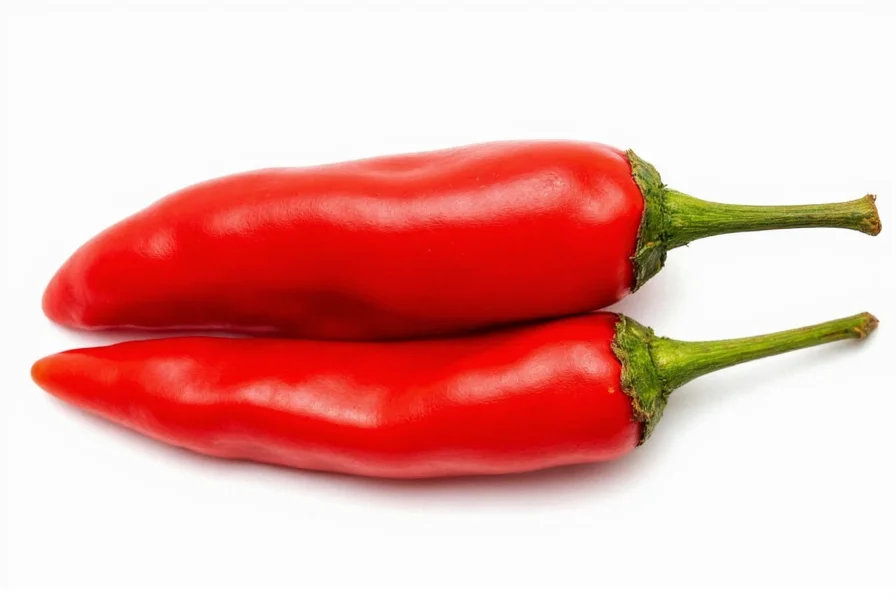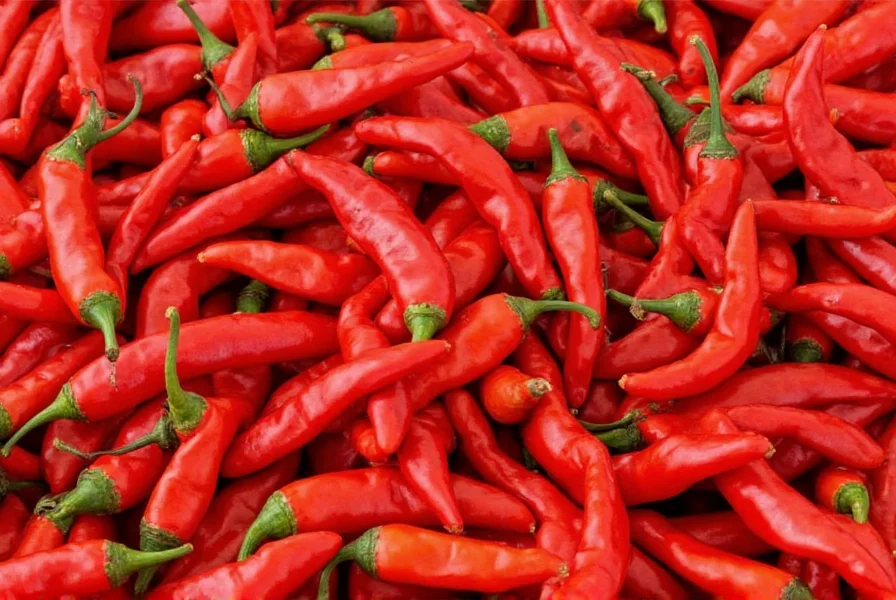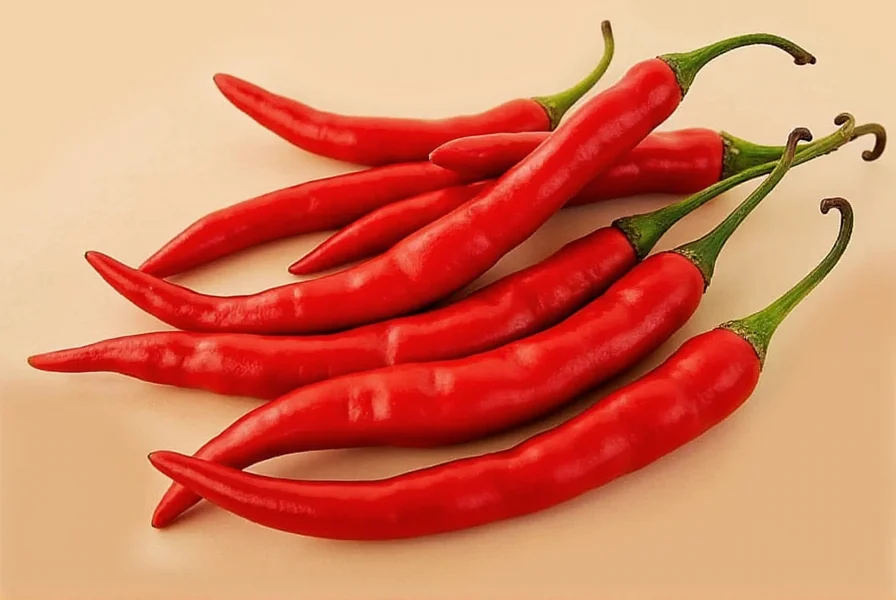Cayenne pepper, scientifically known as Capsicum annuum var. annuum, belongs to the nightshade family (Solanaceae) alongside tomatoes, eggplants, and bell peppers. This slender, tapered chili typically ranges from 2-5 inches in length and transitions from green to vibrant red as it matures. The heat in cayenne comes from capsaicin, the active compound responsible for its fiery sensation that registers between 30,000-50,000 on the Scoville scale—significantly hotter than jalapeños (2,500-8,000 SHU) but milder than habaneros (100,000-350,000 SHU).
Native to French Guiana in northeastern South America, cayenne pepper spread globally through European exploration. Christopher Columbus mistakenly called them "peppers" due to their pungency resembling black pepper (Piper nigrum), though they're botanically unrelated. Today, major producers include India, China, Mexico, and the United States, with variations in heat and flavor depending on growing conditions—a phenomenon known as terroir in chili cultivation.
Botanical Characteristics and Identification
Cayenne peppers grow upright on bushes reaching 2-4 feet tall, distinguishing them from some pepper varieties that hang downward. Their smooth, glossy skin encases white to pale green seeds (which contain concentrated capsaicin). When dried and ground, they become the familiar red cayenne powder found in spice racks worldwide. Key identifiers include:
| Characteristic | Description |
|---|---|
| Shape | Long, tapered (2-5 inches), often curved |
| Color progression | Green → Orange → Bright red when mature |
| Heat level | 30,000-50,000 Scoville Heat Units |
| Flavor profile | Earthy, slightly fruity with intense heat |
| Common names | African bird pepper, goat pepper, red hot chili pepper |
Culinary Applications of Cayenne Pepper
Chefs and home cooks value cayenne pepper for its ability to add heat without overwhelming other flavors. Unlike some hotter peppers, cayenne delivers a clean, immediate burn that dissipates relatively quickly. Common culinary uses include:
- Spice blends: Essential in Cajun seasoning, curry powders, and Old Bay seasoning
- Sauces and condiments: Key ingredient in hot sauces, sriracha, and chili oil
- Dry rubs: Adds heat to meat and fish preparations
- Baking: Surprisingly used in chocolate desserts to enhance flavor complexity
- Preservation: Natural antimicrobial properties aid food preservation
When cooking with cayenne, remember that heat intensifies over time. Start with 1/8 teaspoon per dish and adjust gradually—its potency means a little goes a long way. For those sensitive to capsaicin, wearing gloves during handling prevents skin irritation.

Health Benefits and Scientific Research
Capsaicin, cayenne pepper's active compound, has been extensively studied for potential health benefits. Current research indicates:
- Pain management: Topical capsaicin depletes substance P, reducing pain signals (used in arthritis and neuropathy creams)
- Metabolism boost: Studies show temporary metabolic increase of 4-5% after consumption
- Circulation improvement: Causes vasodilation, potentially lowering blood pressure
- Digestive support: May stimulate digestive enzyme production
However, claims about cayenne pepper for weight loss or curing diseases often exceed current scientific evidence. The National Center for Complementary and Integrative Health notes that while capsaicin shows promise, more rigorous human studies are needed. Those with gastrointestinal conditions should consult doctors before consuming large amounts.
Cayenne Pepper vs Similar Varieties
Many confuse cayenne with other red peppers. Understanding these distinctions helps in proper usage:
- Cayenne vs red pepper flakes: Commercial "red pepper flakes" usually contain a mix of辣椒 varieties, while pure cayenne is a specific pepper type
- Cayenne vs paprika: Paprika ranges from sweet to hot but generally milder (500-1,000 SHU for sweet varieties)
- Cayenne vs chili powder: "Chili powder" in the US typically refers to a blend containing cumin, garlic, and other spices plus ground chilies
- Cayenne vs bird's eye chili: Bird's eye chilies (50,000-100,000 SHU) are significantly hotter and more pungent

Growing and Harvesting Cayenne Peppers
Cayenne peppers thrive in warm climates with 70-85°F temperatures and well-draining soil. They require 70-80 days from transplanting to maturity. Gardeners should:
- Start seeds indoors 8-10 weeks before last frost
- Provide 6-8 hours of direct sunlight daily
- Water consistently but avoid waterlogging
- Harvest when peppers turn bright red and feel firm
Drying cayenne peppers preserves them for year-round use. The traditional method involves threading stems and hanging in a warm, dry place for 2-3 weeks. Once brittle, they can be ground into powder using a spice grinder. Properly stored in airtight containers away from light, dried cayenne maintains potency for 1-2 years.
Safety Considerations
While generally safe as a food ingredient, cayenne pepper requires careful handling:
- Wear gloves when cutting to prevent skin irritation
- Avoid touching eyes or face during preparation
- Rinse affected skin with milk or oil (not water) if burned
- Those with GERD or ulcers should limit consumption
- Consult doctors before using medicinally, especially with blood thinners
Frequently Asked Questions
What is the difference between cayenne pepper and regular red pepper?
Cayenne pepper is a specific variety of hot chili pepper (Capsicum annuum var. annuum), while "red pepper" is a generic term that could refer to any mature red pepper including bell peppers, paprika, or other chili varieties. True cayenne measures 30,000-50,000 Scoville units, significantly hotter than sweet red bell peppers (0 SHU) and milder than some other hot varieties like habaneros.
How hot is cayenne pepper compared to other common peppers?
Cayenne pepper ranges from 30,000-50,000 Scoville Heat Units (SHU). For comparison: jalapeños measure 2,500-8,000 SHU, serranos 10,000-23,000 SHU, and habaneros 100,000-350,000 SHU. This places cayenne in the medium-hot category—significantly spicier than jalapeños but milder than the hottest pepper varieties.
Can cayenne pepper really boost metabolism?
Research shows capsaicin, the active compound in cayenne pepper, can temporarily increase metabolic rate by approximately 4-5% for about 20-30 minutes after consumption. While this effect is measurable, it's relatively modest and shouldn't be considered a significant weight loss solution on its own. The metabolic boost would equate to burning roughly 10-25 extra calories per meal containing cayenne.
What are the main culinary uses for cayenne pepper?
Cayenne pepper is widely used in spice blends (Cajun seasoning, curry powders), hot sauces, dry rubs for meats, and as a seasoning in soups and stews. Professional chefs appreciate its clean heat that doesn't overpower other flavors. It's also used in baking (particularly chocolate recipes) to enhance flavor complexity, and in preservation due to its natural antimicrobial properties.
How should I store cayenne pepper to maintain freshness?
Store dried cayenne pepper in an airtight container away from light, heat, and moisture. A cool, dark cupboard works well for short-term storage (up to 6 months), while the freezer preserves potency for 1-2 years. Fresh cayenne peppers should be refrigerated in a paper bag in the crisper drawer and used within 2-3 weeks. Avoid storing near onions or garlic, which can accelerate spoilage.











 浙公网安备
33010002000092号
浙公网安备
33010002000092号 浙B2-20120091-4
浙B2-20120091-4